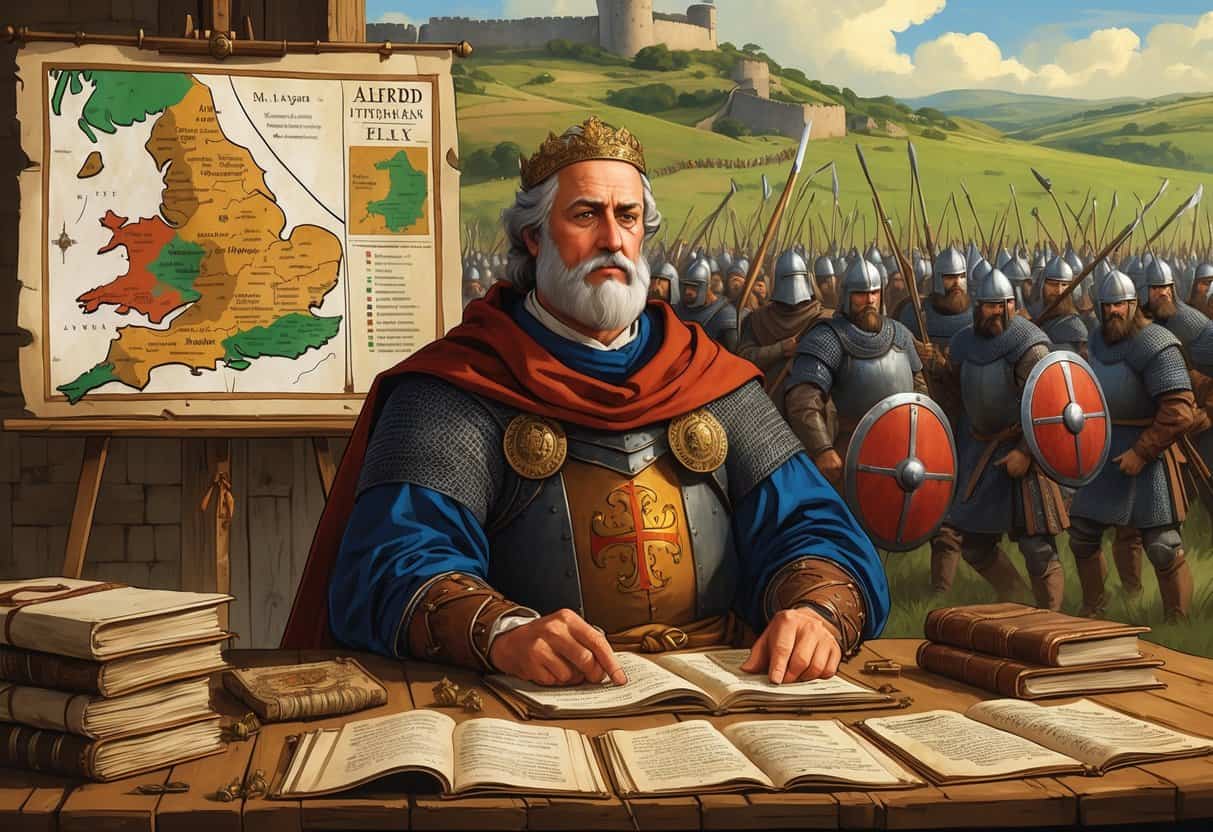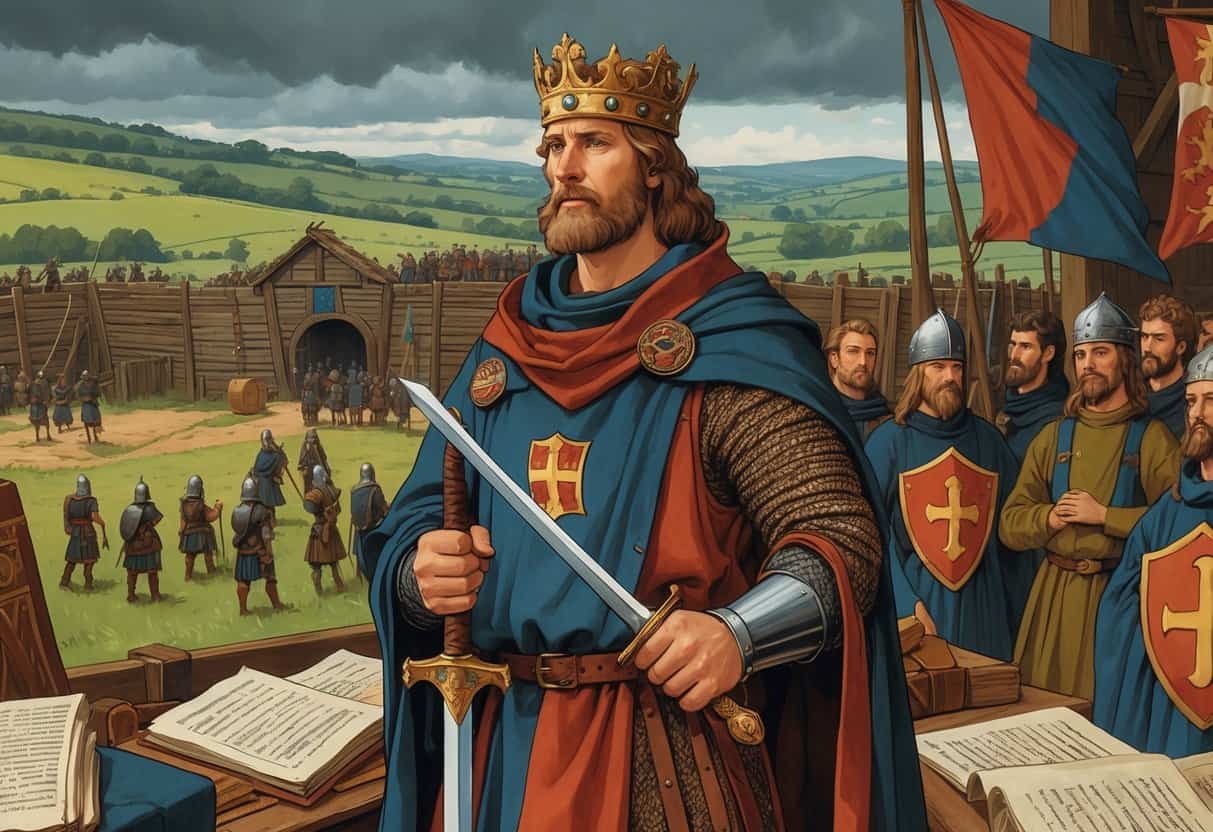Alfred the Great is remembered for his military skill and for reforms that shaped Anglo-Saxon England. He strengthened his kingdom by building fortified towns called burhs, which helped fend off Viking attacks.

But Alfred’s efforts went way beyond warfare. He worked to improve education, translating important texts into Old English so more people could actually read them.
These reforms unified his people and built a legacy that echoed through English history.
Key Takeaways
- Alfred fortified England with burhs and an organized army.
- He pushed legal and educational reforms to strengthen society.
- His leadership left a deep mark on England’s story.
Alfred the Great’s Rise and Leadership

Let’s look at how Alfred became king, what Wessex was like before his rule, and how he gained and held royal power. These points show why he stands out among Anglo-Saxon kings.
Background of Wessex
Wessex was one of a handful of Anglo-Saxon kingdoms in 9th-century England. It sat in the south and southwest.
Before Alfred, Wessex faced constant Viking threats, making survival feel pretty uncertain.
The kingdom had farmland and a few towns, but it wasn’t the biggest or strongest. People lived under local lords, all answering to the king.
Wessex’s strength really depended on defending against Vikings and holding its lands together.
Genealogy and Ascension
Alfred was born into the royal House of Wessex. His father was King Æthelwulf, and Alfred took the throne after his older brother, King Æthelred I, died.
Kingship was mostly hereditary, so Alfred was next in line. But just being born royal wasn’t enough—he had to win over nobles and key leaders in Wessex to keep his crown.
Kingship and Royal Power
Once king, Alfred worked to strengthen his rule. He was both a military leader and a lawmaker.
He centralized control by reforming the army and improving defenses. Alfred also updated laws to keep the peace.
His leadership style mixed personal bravery with smart planning. He focused on uniting his kingdom and making sure people accepted his rule.
That balance of force and good government made him a respected king.
Reforms in Governance and Society
Alfred made changes that shaped how the kingdom was run and how people learned and practiced faith. He improved the legal system, revived education, and supported the church and monasteries.
Legal System and Public Administration
Alfred created clearer laws by blending old Anglo-Saxon codes with Christian ideas. He wrote these laws in Old English so more folks could understand them.
Local courts became more organized and fair. He also strengthened the roles of officials to better manage towns and regions.
These reforms cut down on disorder and made people more loyal to the king.
Educational and Literary Revival
Alfred believed education mattered. He translated important Latin works into Old English, making knowledge more accessible.
This helped raise literacy, even as it protected Anglo-Saxon culture.
He encouraged the writing of the Anglo-Saxon Chronicle, a record of your people’s history. Alfred pushed a literary revival, inspired in part by the Carolingian Renaissance on the continent.
Religious Changes and Monasteries
As a Christian king, Alfred backed the church’s role in society. He restored and built monasteries, like Hyde Abbey, which became centers of learning and spiritual life.
He used Christian values to shape politics and law. Monasteries preserved important texts and kept religious teachings alive.
The church became a strong partner in his reforms, helping improve morals and community ties.
Warfare and Defense Strategies
Alfred faced the Viking threat with strong defenses, army reforms, new ships, and some big battles. His choices helped protect Wessex and push back Danish invasions.
Viking Threat and Invasions
Viking invaders—especially the Great Heathen Army—were a constant danger to southern England. These weren’t just quick raids; they wanted land and wealth.
Wessex was often under huge pressure. The Vikings wanted to control it, forcing Alfred to rethink how to defend his kingdom.
Military Reforms and the Burghal System
Alfred changed the way the army worked. He set up a rotation system—half the soldiers could rest, while the other half fought or guarded towns.
He built burhs, or fortified towns, at key points. These acted as strongholds and safe places for locals.
Burhs stopped Vikings from moving freely and forced them into tough battles.
| Key Points of Burghal System | Purpose |
|---|---|
| Network of fortified towns | Block Viking movement |
| Military structure for defense | Support rotating troops |
| Strong points in Wessex | Protect land and people |
Naval Innovations
Alfred realized Viking raids often came by sea. So he built ships that were faster and easier to handle.
These new ships let his navy chase Viking longboats and intercept them early.
He trained sailors for naval battles—a big shift, since Vikings ruled the seas. The navy guarded rivers and coasts, making surprise attacks harder.
Notable Battles and Victories
The Battle of Edington in 878 was a turning point. Alfred’s forces defeated the Danes led by Guthrum after months hiding out at Athelney.
This win forced the Danes to accept peace and convert to Christianity.
Afterward, Alfred worked with his son Edward the Elder and Æthelred to keep pushing back the Vikings. These battles helped keep Wessex safe and set the stage for a more united England.
Impact and Legacy on Anglo-Saxon England
Alfred the Great’s actions changed Anglo-Saxon England—military victories, political unity, and cultural reforms all played a part. He shaped the kingdom’s structure and influenced future rulers.
Consolidation of the Anglo-Saxon Kingdoms
Alfred helped unite parts of the Heptarchy, especially Wessex and Mercia, under stronger rule. Through war and diplomacy, he brought order to a land once split among kingdoms like Northumbria and East Anglia.
He built burhs to protect people from Viking attacks and to serve as centers of trade and government. Strategic marriage alliances, like his marriage to Ealhswith, also helped solidify his family’s claim to the throne.
These moves set things up for his grandson Athelstan, who later became the first king of a more united England.
Relations with Vikings and the Danelaw
Alfred stood up to Viking invasions, defending Anglo-Saxon England from attacks on places like Lindisfarne. He fought Vikings in battle and at the negotiating table.
After battles like Ashdown, Alfred made peace with the Viking leader Guthrum. This created the Danelaw, giving Vikings part of England and bringing peace to the rest.
Alfred’s laws drew a border and managed Viking presence without endless fighting. This let both groups live in relative peace—at least for a while.
Cultural and Political Influence in Great Britain
Alfred pushed for education and law reform, hoping to rebuild Anglo-Saxon culture after years of chaos. He even took the time to translate key Latin texts into Old English, so more people could actually understand them.
Winchester, under his watch, turned into a hub for learning and administration. It really cemented the idea of a strong, literate monarchy.
His work as a statesman tied together old Anglo-Saxon customs with fresh Carolingian ideas from Europe. That blend sparked a political culture that felt pretty unique for its time.
Alfred’s legacy stuck around. You can still spot his influence in English law and royal authority, echoing centuries after he was gone.